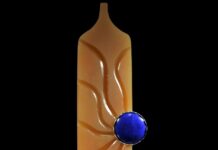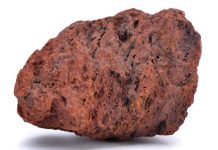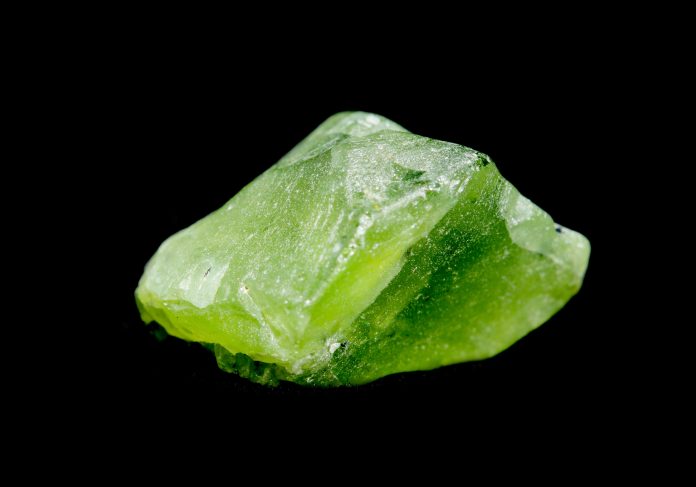
Peridot crystals became big news in 2018 when the media reported that gemstones were falling from the sky on Hawaii’s Big Island. Accompanying images showed smiling residents holding handfuls of small peridot crystals that they had gathered from the ground in a matter of minutes. The thought of gemstones free for the taking enticed many would-be collectors from mainland areas like the Peridot Mesa Gem Mine to drop everything and fly to Hawaii to get in on the action.

But then geologists from the United States Geological Survey and the University of Hawaii stepped in to point out that very few of the peridot crystals were actually of gem quality. Yes, the stones did have peridot’s pleasing lime-green color, but most of these peridot crystals were fractured, heavily included, or too small to facet into gemstones.
Volcanic Origins of Peridot Crystals
These gemstones that fell from the sky were one of the olivine-group minerals that are common in Hawaii’s bedrock basalt. They were a component of the magma that the erupting Kilauea volcano had ejected into the air. While airborne, they had separated and “rained” onto the ground. While these green crystals did not have much gemological value, the media attention triggered a worldwide spike in the sales of peridot jewelry.
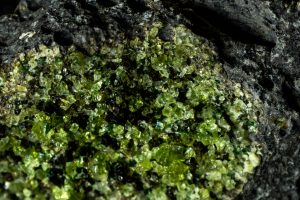
Peridot and diamonds are the only gemstones that form in the high temperatures and pressures of the Earth’s upper mantle. Peridot forms at depths of more than 25 miles and is transported to the surface in volcanic eruptions of deeply sourced, silica-poor magmas that solidify into basalt, a volcanic rock.
What Are Peridot Crystals?
Peridot is the transparent, lime-green colored variety of forsterite (magnesium silicate, MgSiO4). Forsterite and fayalite (iron silicate, FeSiO4) are end-members of a solid-solution series formed by the mutual substitution of iron and magnesium. When nearly pure, forsterite is colorless and fayalite is brownish-black. Technically, forsterite becomes fayalite when the weight of the iron exceeds that of the magnesium.
Peridot’s diagnostic lime-green color is caused by a precise iron content of 15 percent. From a gemological standpoint, this percentage is critical: Too much iron creates brown tones that “muddy” the green color; too little weakens the color intensity.
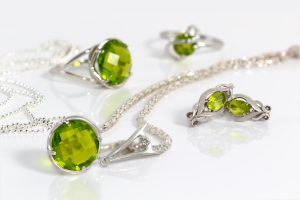
Where Peridot Crystals Are Found: Zabargad
Zabargad, an island in the Red Sea off the Egyptian coast, was the first great source of peridot. Originally thought to be of volcanic origin, Zabargad is an upthrust island created by tectonic plate collision. The island’s bedrock consists of peridotite, a coarse-grained igneous rock that originated deep in the mantle. Zabargad’s peridotite, rich in olivine-group minerals, is laced with erratic veins of gem-quality peridot.
The Egyptians began systematically mining peridot on Zabargad around 300 B.C. At that time, Egypt was the only significant source of both peridot and emerald, two gems that have been confused throughout much of history.
Cleopatra VII, the queen of Egypt’s Ptolemaic Kingdom, is said to have owned a collection of large, deep-green emeralds of legendary beauty. But the emeralds found in Egypt are small, translucent to opaque, pale in color, and of generally poor quality. Most historians believe that Cleopatra’s fabled emeralds were really Zabargad peridots.
Many European religious artifacts are set with green gems that have traditionally been labeled as “emerald,” but are, in fact, peridot. As one example, the three magnificent, 200-carat “emeralds” adorning the Shrine of the Three Holy Kings in Germany’s Cologne Cathedral are actually peridot.
Peridot Found in Meteorites
The rarest type of peridot—and perhaps the rarest of all gems—is pallasitic peridot, also known as “palladot.” It occurs only in pallasites, a class of exceedingly rare stony-iron meteorites. Of the roughly 70,000 officially recognized meteorites, only 158 are pallasites.
Pallasites are thought to have originated within small planets or large asteroids where molten nickel-iron cores contacted a semi-molten silicate mantle. When these planets and asteroids later collided, their fragments became meteors.
Pallasites which consist of olivine-group minerals, including various amounts of gem-quality peridot, embedded within a metallic iron-nickel matrix, are the most visually attractive of all meteorites. When thinly sliced, polished, and backlit, they make eye-catching displays that resemble stained-glass windows. Pallasitic peridot is believed to have originally had a lime-green color that has since altered to a citrine-like golden yellow.
Not only is pallasitic peridot extremely rare, but most have also been shocked and fractured by atmospheric entry or meteoric impact, and have no gemological value. Nevertheless, small amounts of pallasitic peridot are sometimes cut into gems. Loose, faceted 0.2-carat palladot gems sell for about $600, and 1.0-carat gems for as much as $10,000.
🔎 Frequently Asked Questions About Peridot CrystalsQ: What are peridot crystals made of?A: Peridot crystals are the gem-quality form of the mineral olivine, composed primarily of magnesium and iron silicate. The unique green color of peridot comes from the iron content within the crystal structure—unlike many gemstones, its color is intrinsic and not due to impurities. Q: Where are peridot crystals found?A: Peridot crystals form deep within the Earth’s mantle and are brought to the surface through volcanic activity. Major sources include Arizona, Hawaii, Myanmar (Burma), Pakistan, and China. Peridot has also been found in pallasite meteorites, making it one of the few gems with both terrestrial and extraterrestrial origins. Q: Is peridot a rare gemstone?A: While small peridot crystals are relatively common, large, high-quality specimens with excellent clarity and color are much rarer. Meteorite-derived peridot is especially rare and prized by collectors for its cosmic origin. Q: How can I tell if a peridot is real?A: Real peridot crystals will show double refraction when viewed under magnification (you may see two lines for each facet edge). They typically have a lime to olive-green hue, without the deep forest green seen in some fakes like green glass or cubic zirconia. Testing hardness (6.5–7 on the Mohs scale) and checking for natural inclusions can also help. Q: What is the spiritual meaning of peridot?A: In metaphysical circles, peridot is believed to be a stone of compassion, bringing balance, healing, and abundance. It is often used in crystal healing to dissolve negative patterns, enhance confidence, and attract prosperity. Q: Why is peridot the birthstone for August?A: Peridot has been associated with the month of August since ancient times. Its vibrant green color symbolizes growth, renewal, and energy, aligning with the peak of summer. It became the official August birthstone in the early 20th century as part of standardized birthstone charts. Q: Can peridot be used in jewelry?A: Yes! Peridot is a popular choice for rings, necklaces, earrings, and bracelets. While it’s softer than diamonds or sapphires, it’s still durable enough for everyday wear with some care. Its brilliant green sparkle makes it especially appealing in both modern and vintage settings. |
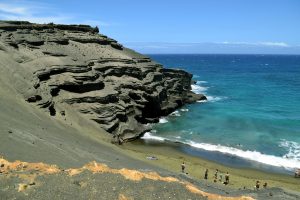
Peridot Beaches and Lore
Most Hawaiian basalt contains significant quantities of olivine, including bits of peridot. These crystals are known locally as “Hawaiian diamonds.” One prominent olivine source is Oahu’s Diamond Head promontory. Another is the Big Island’s Papakolea Beach, one of only four green-sand beaches in the world.
Papakolea Beach, which has a peridot-green color, formed as ocean waves washed away the other components of weathered basalt, leaving a concentration of denser peridot crystals. Although most are only sand-grain-sized, gems are occasionally faceted from the larger crystals found on the beach.
Some Big Island residents suggest that the gemstones that fell from the sky in June 2018 were gifts from Pele, the Hawaiian goddess of fire, lightning, and volcanoes, as an apology for Kilauea’s unruly behavior. If that is true, then Pele chose a very special gift— peridot, the only gemstone to come from the Earth’s mantle, the sky, and from space.
This rock science column about peridot crystals previously appeared in Rock & Gem magazine. Click here to subscribe. Story by Steve Voynick.









